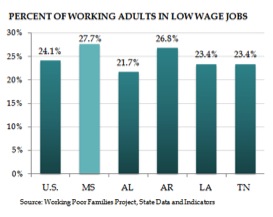Employment Is Not Enough To Keep Many Mississippi Families Out Of Poverty: Part 2
June 20th, 2011
A previous post covers the rising number of working families in Mississippi living on income below the poverty level. Today, we take a closer look at how wages impact the number of working poor families in the state and consider how economic insecurity varies by family characteristics.
Click to enlarge
Low-wage Jobs:

The prevalence of low-wage jobs contributes to the relatively high concentration of working poor families in the state. How are low-wage jobs defined? Here, we set a threshold as the hourly wage needed for a full-time worker to keep a family of four out of poverty, adjusted for the state cost of living. Because the cost of living is slightly lower in the state, Mississippi’s threshold is actually below most states at $9.54¹.
More than one in four working adults – 27.7 percent – are in low-wage jobs that pay below this level. Mississippi’s portion of low-wage workers is among the nation’s highest and is the highest in the Mid South. See Chart.
Often, workers in low-wage opportunities may not receive health insurance through their employer and may work in entry level jobs that are more vulnerable to fluctuations in work hours and periods of unemployment. A lack of benefits, fluctuations in work hours or extended periods without work further challenge workers that are already facing economic insecurity.
Working Poor Families by Race and Gender:
Families headed by a minority adult are more likely to be low-income or poor than families headed by a white adult. One in every four working families headed by a minority parent is poor in Mississippi.² In 2009, there were 16,600 working poor families headed by white adults, compared to 34,600 working poor families headed by a non-white adult. Across races, single parents, particularly women, are more likely to have inadequate income than two-parent households or those headed by men.³
In our next post, we will focus on occupations that are not traditionally pursued by women, and we will explore which of these nontraditional occupations offer opportunities for greater economic security for women across different levels of skill and educational attainment.
Author:
Sarah Welker, Policy Analyst
¹Working Poor Families Project. 2011 State Data and Indicators.
²Overlook and Undercounted Making Ends Meet in Mississippi.
³Low wage figures developed by the Working Poor Families Project. For more information see:http://www.workingpoorfamilies.org.





